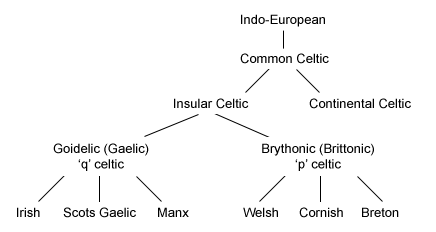Table of Contents
History - Alphabet - Spelling - Pronunciation - Grammatical Changes - Basic Sentence Structure - The Article - Nouns - Verbs - Commonly Confused Words - Compound Prepositions - Prefixes - Dictionaries - Other Resources - Common phrases - Similar English words -
VocabularyHistory
The Irish language belongs to the family of Celtic languages. By the 5th century B.C., the Celtic tribes occupied much of Europe. The word "Celt" is derived from the Greek name for these tribes, "Keltoi" (meaning "secret people"). The Celtic languages evolved from Indo-European, which is the common ancestor of many of the languages in Europe and southern Asia.
The development of the Celtic languages is illustrated below. Eventually the forms of the Celtic languages spoken on the continent died out, leaving only the insular forms. At some point, the insular Celtic language divided into "q-Celtic" or Goidelic (from Goidel 'Gael'), which retained the original Indo-European q sound, and "p-Celtic" Brythonic (from Brython 'Briton'), which replaced the q sound with a p sound.
The modern Celtic languages are Irish, Scottish Gaelic, Manx, Welsh, Cornish, and Breton. You will note that the term "Gaelic" is only applied to Irish, Scottish Gaelic, and Manx.

The history of Irish may be divided into the following periods:
- Old Irish (C.E. 600-900)
- Middle Irish (C.E. 900-1200)
- Early Modern Irish (C.E. 1200-1600)
- Modern Irish